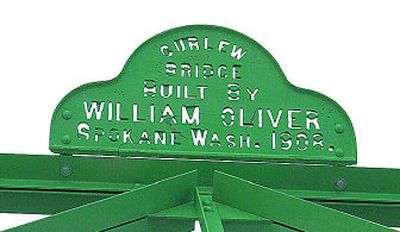Spanning a century of memories

CURLEW, Wash. – People came from all over northern Ferry County on Saturday to celebrate the return of the nearly century-old, one-lane Curlew bridge.
They could have had a new two-lane concrete bridge like everyone else, but there would have been nothing to celebrate in that.
People here would rather take the old bridge apart piece by piece, haul it to Spokane for an overhaul and put the numbered pieces back together. Even if it requires a couple of years of driving an extra mile to get to state Route 21.
And that’s exactly what happened.
“Everyone agreed we didn’t want a two-lane bridge,” said Donna Bishop, who served on a save-the-bridge committee. “That’s part of living in Curlew. You wait for your neighbor to come through.”
Curlew residents nearly tarred and feathered county engineer Keith Muggoch in June 2004 when he told them the metal-truss bridge they had been using since 1908 was too corroded and weak for continued use. A new bridge would be better anyway, he suggested.
A standing-room-only crowd at the Curlew community hall told Muggoch to think again. A 14.7-foot-wide roadway was all they wanted, thank you.
“I’m very glad to be here under different circumstances,” Muggoch said Saturday when residents again packed the community hall.
Muggoch said he was “all aquiver” that the $1.4 million project had saved one of fewer than 50 remaining examples in the United States of a steel pin-connected Parker truss bridge. The 182-foot bridge cost $7,975 when the William Oliver Co. of Spokane built it.
“They built it in 1908 and guaranteed it for 50 years, so it’s been a good one,” Curlew resident LaRue Lembcke said.
And Curlew residents know a thing or two about bridges. Curlew students have been winning regional model bridge-building contests for the better part of a decade and have won two national championships and three second-place national prizes.
High school junior Matt Ramich has a good chance of winning this year’s regional contest in Spokane on Feb. 26 with a model whose design is “not far off” from the Curlew bridge, according to Jamie Sutherlin, one of several parents who advise the student bridge-builders.
As ever, the Curlew bridge still has a wood-plank surface, but wooden “stringers” supporting the deck have been replaced with steel beams, allowing a threefold increase in the old 5-ton load limit.
County Commissioner Brad Miller said the project “seemed like a long shot” at first, but it turned out that a new bridge would have required a lot of additional land and would have cost about the same amount.
Still, given the complexity of federal regulations, “it may have been nothing less than a miracle” that federal officials agreed to pay for the renovation.
So Miller and others made grateful speeches, TD&H Engineering and Wesslen Contracting presented a slide show of their work, and the crowd tucked into a rib-sticking luncheon of meatballs, sandwiches and potluck desserts.
That was after some 300 people – probably twice the population of the town itself – gathered at the bridge to re-christen it with a parade of antique cars.
“We don’t have much occasion to get together, so we use any excuse,” Ken Helmick said as he and scores of others stood on the bridge and chatted. “And there’s free food involved.”
Curlew Civic Club luncheon server Bruce Wills said he took one look at the crowd and “ran back up here and cooked more meatballs.”
Curlew resident John Lembcke led the parade with his 1923 Ford Model T touring car, which he calls Little Vic in honor of its previous owner, the late Vic Nelson. Lembcke’s not sure, but Little Vic could have been the car a neighbor used to rescue the Lembcke family from a wildfire near their ranch on Long Alec Creek when he was 8.
The Curlew bridge, like Little Vic, brings back memories for Lembcke. For example, the time his onetime schoolmate Glenn Kiehl got his log truck stuck in the bridge in the 1950s.
“He had to chop some bark off the logs to get off the bridge,” Lembcke recalled. That’s not the only memorable thing to happen on the bridge. Beverly Gregor remembered when one of her sons, Louis Miller III, dived off the bridge some 20 years ago in midsummer when the shallow river was even shallower.
He dislocated his shoulder.
Whether you wince or laugh, “there are a lot of memories there,” she said.
General store owner Don Longfellow said local veterans look forward to resuming their practice of tossing a wreath from the bridge during Memorial Day services.
“It’s just a part of our lives,” said Judy Rumsey Thompson, whose family crossed the current bridge’s predecessor in 1900 to homestead in the Malo area.
The current bridge seemed a marvel when it replaced the “corduroy” log-surfaced bridge that her mother’s buckboard horse refused to cross in 1900, Thompson said.
The bridge was much used by horses in its early days, often by children on their way to school – where there was a stable instead of a bus garage.
Danville-area resident Jeanette Strandberg hadn’t planned to attend Saturday’s festivities but changed her mind. There was “just something drawing me back to it,” she said.
That’s where she met her late husband, Oscar Strandberg, in 1955. A Canadian citizen, she had just driven over the bridge with her cousins, Jim and Rose Boltz, on their way back to British Columbia. Her cousins spotted fellow rancher Oscar Strandberg and stopped to chat.
“He was a tall cowboy, and it was love at first sight,” Jeanette Strandberg said.
They began dating and were married in 1957.
“Probably there were a lot of other romances that started on that bridge,” she said.
The bridge has character, she said. “Character is hard to do. I’m very happy that they restored it.”